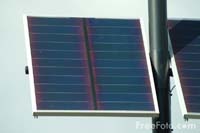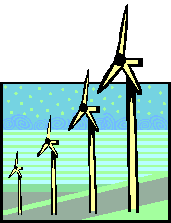 |
Alternatives to Nuclear Energy
|
||||||||||
The initial dream that nuclear energy would be 'too cheap to meter' has proved to be sadly naïve. There are many costs to nuclear power. Some of financial costs paid by the present generation can be quantified, but there are other costs that cannot. The financial cost to future generations and the health costs to both present and future generations are incalculable.
One of the major disadvantages of nuclear power is the waste product that it generates. A problem that has never been satisfactorily resolved and a mess that will be left for future generations to take care of. Future inhabitants of this planet will find it difficult to comprehend why we should have left them such a dangerous legacy. Imagine that nuclear power had been invented a couple of hundred years ago, and we were now left to take care of the waste our ancestors left us. Would we be thanking them? No!!
 |
There are many alternatives to nuclear power and for the sake of our children and their grandchildren we must support and encourage renewable energy projects now. If the money and effort put into the nuclear industry had been invested in alternative, renewable energy sources, their prospects would be very different now.
Wind power is an energy source that is very successfully harnessed on large and small scales all over the world. In this country there are concerns about the turbines visual impact on the landscape, though many people feel that they are one of the more attractive man made objects that appear in our countryside. Surely no one can prefer an electricity pylon - or a nuclear power plant!
There has been vociferous opposition to wind farm proposals all over the country, largely fuelled by supporters of the nuclear industry. In the Government Energy Review in 2003, the nuclear option was left open, despite the fact that most of the nation was against the idea, revealed in various opinion polls. This option was reviewed in 2006 and now nuclear is back on the agenda.
Unfortunately renewables have been seen as an obstacle to more nuclear power and therefore a target for pro-nuclear lobbyists. According to a regional newspaper, key anti-wind campaigners have worked at the Hinkley complex.
 |
There are other alternatives potentially available in the southwest. The technology to harness tidal power is not as well developed as it might be because the nuclear industry has diverted its R&D funding over decades despite the fact that the UK has probably the most favourable conditions in Europe for generating electricity from the tides, with the total potential put at about 20% of current UK electricity requirements. The Severn estuary is a prime candidate for harnessing tidal power as the tidal range in the estuary is the second highest in the world.
In April 2006 it was announced that a £10bn Severn barrage is among options for future energy provision recommended by the Welsh Assembly Government. However, most major green groups are against this project. On the other hand there is wide support for tidal lagoons which have less impact on local ecology whilst requiring less carbon-emitting construction. One estimate for the Severn barrage project suggested it would need a volume of concrete and ballast the size of the
Mendips. As a project that would take decades to build it would start generating well after the ten-year window proposed by Greenpeace and other groups that we nail down our carbon emissions. Click Here to read more about the tidal lagoon.
Solar power at first seems an unlikely source of energy in the UK - we complain that we don't get to see the sun often enough! But the sun rises every day and its energy can be converted directly into electricity using photovoltaic cells. We are all familiar with PV cells on calculators and this can be scaled up. The great attraction of PV technology is that it delivers electricity at the point of use, for example panels can be discreetly integrated into buildings to supply the buildings themselves or to smaller applications, eg parking meters.
The other way of harnessing the sun's heat is to heat water in a process rather like your central heating in reverse. A radiator (usually on the roof) will be heated by the sun and then bring heated water into the house to supply hot water or 'assist' a more conventional heating system. This has proved very successful where large amounts of hot water are used, eg a swimming pool.
Another possible alternative source of energy in the future is nuclear fusion (as opposed to fission), a nuclear reaction that does not generate as much radioactive waste but still discharges low-level waste. While fusion power offers the potential of an almost limitless source of energy, it also presents some formidable scientific and engineering challenges and vast amounts of EU money are currently being spent on it. It is based on fusing light nuclei such as hydrogen isotopes to release energy, the process similar to that which powers the sun and other stars. However, some of its problems are comparable to current nuclear power and it cannot be seen as a suitable solution.
THE BURNING ANSWER
A User's Guide to the Solar Revolution by Keith Barnham Barnham answers the burning question of our age: how to supply the power our society demands while avoiding environmental catastrophe. The threat of global warming, oil depletion and nuclear disaster is ever-present. There is a growing risk of environmental damage from fracking and shale-oil extraction, deforestation and drilling for fossil fuels in sensitive environments. |

Bird watchers winking on the old sea wall Yes to the wind and shining sun Leave these hills to the swallows and the moles Yes to the wind and shining sun Rise like lions after years of slumber Yes to the wind and shining sun Pete the Poet www.poemsforallevents.co.uk |
 |
|---|
|


